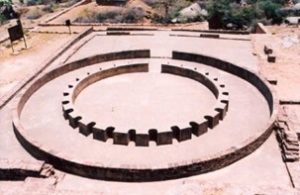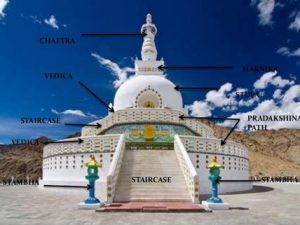The stupa (“stupa” is Sanskrit for heap) is an important form of Buddhist architecture, though it predates Buddhism. Syllabus of Art and culture in UPSC mains GS paper 1 has Architecture of the IVC era
TOPICS
- Stupa Architecture
- Context
- Terminology
- Basic Structure
STUPA ARCHITECTURE
It is generally considered to be a sepulchral monument—a place of burial or a receptacle for religious objects. At its simplest, a stupa is a dirt burial mound faced with stone. In Buddhism, the earliest stupas contained portions of the Buddha’s ashes, and as a result, the stupa began to be associated with the body of the Buddha. Adding the Buddha’s ashes to the mound of dirt activated it with the energy of the Buddha himself.
Early stupas
Before Buddhism, great teachers were buried in mounds. Some were cremated, but sometimes they were buried in a seated, meditative position. The mound of earth covered them up. Thus, the domed shape of the stupa came to represent a person seated in meditation much as the Buddha was when he achieved Enlightenment and knowledge of the Four Noble Truths. The base of the stupa represents his crossed legs as he sat in a meditative pose (called padmasana or the lotus position). The middle portion is the Buddha’s body and the top of the mound, where a pole rises from the apex surrounded by a small fence, represents his head. Before images of the human Buddha were created, reliefs often depicted practitioners demonstrating devotion to a stupa.
The ashes of the Buddha were buried in stupas built at locations associated with important events in the Buddha’s life including Lumbini (where he was born), Bodh Gaya (where he achieved Enlightenment), Deer Park at Sarnath (where he preached his first sermon sharing the Four Noble Truths (also called the dharma or the law), and Kushingara (where he died). The choice of these sites and others were based on both real and legendary events.
CONTEXT
- Buddhism was the earliest Indian religion to require large communal spaces for worship.
- This led to three types of architectural forms the stupa, the vihara and the Chaitya
- Many religious Buddhist shrines came up between the 1st century BC – 1st century AD.
- The term stupa has been referred to in Rig Veda but not in the context as we know it
- The term then referred to the fire coming out of the sacrificial altar
- Stupa, originally the focus of a popular cult of the dead, is a large burial mound containing a relic of the Buddha.
- It celebrates the Buddha’s parinirvana (end of cycle of suffering), symbolizes his eternal body, and is an object of worship
- Not many stupas have survived from these early times but the Great Stupa at Sanchi in Madhya Pradesh with its majestic four gateways has survived intact.
- There is evidence of community patronage of landowners, merchants, officials,monks, nuns and artisans associated with these Buddhist projects.
- Initially stupas were Buddha's relic Then it got extended to his followers as well and gradually stupa itself became an object of worship.
- According to Buddhist tradition, Ashoka built 84000 stupas.
- Some stupas have been found in Sanchi, Sarnath, Deorkothar, Lumbini. Huen Tsang mentions seeing stupas at Tamralipti, Karnasuvarna, Samtata.
STUPA
- The word Stupa is mentioned in the Rigveda, Atharvaveda, Vajasaneyi Samhita, Taittriya Samhita, in the Panchavimsata Brahmana.
- Rigveda refers to a Stupa raised by the King Varuna above the forest in a place having no foundation
- Pali word “Thupa” means a conical heap, a pile or a mound or a conical or bell shaped shrine containing a relic
- A stupa was a funeral mound which was originally made of earth but later on with bricks and stone
- It was also called “Chaitya” which literally means a monument on the spot of the funeral pyre
- It was usually the practice to plant a tree on the spot where the dead body was buried or burnt è This sa- cred tree is called Chaitya Tree.
- Sometimes, a monument was raised on the spot to enshrine the remains of the dead person in the form of the burnt bones and ashes
- After the demise of Buddha and his cremation at Kushinagar and later the corporeal relics was distributed among 8 Mahajanpadas
- Initially 8 Stupas (Saririka Chaityas) were constructed at 8 centresèRajagrihya, Vaishali, Kapilavastu, Allakappa, Ramagrama, Vethadipa, Pava and Kushingara
- Drona the Brahmin who initiated the distribution, himself erected a Stupa to enshrine the urn that was used to divide the relics
- Mauryas arrived too late for a share of the relic and were given the wood ashes from the cremation pyre, and they too built a Stupa in their city of Pipphalavana
- Thus all together 10 Stupas were erected e. 8 on corporeal relics and two on urn and over wood ashes by Drona and the Mauryas respectively.
- Stupa is the built on the relics of buddha like his bodily remains and objects used by him
- They were built by the donations of king specially of Satavahanas; guilds such as ivory workers; men and women, bhikkhus and bhikkhunis.
- Jatakas mentions about the existence of Stupa but does not throw any light on the structural details of stupa
- Sujata Jataka and Bahiya Sutta describes Stupas as raised earthen mounds to commemorate the de- ceased è This indicates that most probably prior to Ashoka most of the stupas were made of clay
- Archaeological excavations and findings proved that during Ashoka’s reign use of bricks and stone for constructional purpose became popular.
Stupa Architecture in North India
• There is very little information regarding the history of the development of Stupa architecture in north.
• The Gupta period is considered as the golden age of Indian history.
• Guptas were Vaishnavites but were tolerant towards Buddhism.
• It is said that the Stupa at Sarnath was built during the Gupta period
Stupa Architecture in South India
• The architectural movement in the south (Andhra) flourished under Satavahanas.
• Rock cut architecture of Hinayana sect became more prominent.
|
Northern India |
Southern India |
|
Presence of torana dwara |
No torana dwara |
|
Circular stupa |
Non circular stupa |
|
No decorations on hemispheres |
Decorations present on hemisphere |
| Buddha depicted by symbols |
Buddha depicted by symbols as well as in anthropomorphic forms |
STRUCTURE OF STUPA - TERMINOLOGY

Anda
- It is the semi-circular mound built on
Harmika
- It is the balcony like structure above
- It is believed to be the livingplace of
Yashti
- It is the mast above harmika surmounted by
Railing
- It is around the mound believed to separate the stupa from surroundingworld and make it
Chatra
- It is the umbrella built on the top of the dome
Pradakshinapatha
- It is the path for clockwise circumambulation surrounded by a fence built encircling the
- Stone balustrade (wooden fence) consisted of thabas (octagonal upright posts) capped by uhnisa (continu- ous caping stone).
- These posts are connected by 3 horizontal rails called
Torana
- Gateways having sculptures depicting Jataka Tales
Medhi
- Square platform
Aniconist buddha
- It is related with Hinayana or Theraveda Buddhism.
- It prohibits representing Buddha in human
- Instead they use symbol è Example Empty seat to indicate meditation of Buddha; wheel represent Dhar- machakra and first sermon of Buddha in sarnath, stupa indicate mahaparinirbana of
BASIC STRUCTURE OF STUPA
- The stupa consists of a square platform knows as medhi.
- On medhi there is a hemispherical structure which encloses a casket
- The medhi is surrounded by vedika(boundary wall).
- Between the medhi and the vedika was pradakshina path or the circum-ambulatory.
- On the stupa there was harmika followed by one or more chatris which signified ‘axis mundi’ or axis of the world.


- The shape of the stupa represents the Buddha, crowned and sitting in meditation posture on a lion throne.
- His crown is the top of the spire; his head is the square at the spire's base; his body is the vase shape; his
- legs are the four steps of the lower terrace; and the base is his throne.
The stupa represents the five purified elements
- The square base represents earth
- The hemispherical dome/vase represents water
- The conical spire represents fire
- The upper lotus parasol and the crescent moon represents air
- The sun and the dissolving point represents the element of space

- The core of the stupa was made up of unburnt brick and the outer face of burnt brick, coveredwith thick layer of
- The stupa was crowned by an umbrella of wooden fence enclosing a path for pradaskshina (circumambulatory path).
- • One of the best examples of the structure of a stupa in the 3rdcentury BC is at Bairat in Rajasthan. It is a very grand stupa having a circular mound with a circumambulatory path.
• The great stupa at Sanchi was built with bricks duringthe time of Ashoka and later it was covered with stone and many new additions were made.
• Ashoka was responsible for the construction of several stupas, whichwere large halls, capped with domes and bore symbols of the Buddha.
• The most important ones are located at Bharhut, Bodhgaya, Sanchi, Amravati and Nagarjunakonda.
• In the subsequent century, stupas were elaborately built with certain additions like the enclosing of the circumambulatory path with railings and sculptural decoration.
• There were numerous stupas constructed earlier but expansions or new additions were made in the 2nd
century BC.
• The stupa consists of a cylindrical drum and a circular anda with a harmika and chhatra on the top which remain consistent throughout with minor variations and changes in shape and size.
• The three chhatra on the stupas represent triratnas of Buddhism i.e. Buddha (The enlightened), Dhamma (doctrine) and Sangh (order).
• Apart from the circumambulatory path, gateways were added.
• Thus, with the elaborations in stupa architecture, there was ample space for the architects and sculptors to plan elaborations and to carve out images.

During the early phase of Buddhism, Buddha is depicted symbolically through footprints, stupas, lotus throne, chakra, etc. - This indicates either simple worship, or paying respect, or at times depicts historicization of life events.
- Gradually narrative became a part of the Buddhisttradition
- Thus events from the life of the Buddha, the Jataka stories, were depicted on the railings and toranas of the stupas.
Mainly synoptic narrative, continuous narrative and episodic narrative are used in the pictorial tradition.
While events from the life of the Buddha became an important theme in all the Buddhist monu- ments, the Jataka stories also became equally important for sculptural decorations. - The main events associated with the Buddha’s life which were frequently depicted were events related to the birth, renunciation, enlightenment, dhammachakrapravartana, and mahaparinibbana (death).
- Among the Jataka stories that are frequently depicted are Chhadanta Jataka, Vidurpundita Jataka, Ruru Jataka, Sibi Jataka, Vessantara Jataka and Shama Jataka.
- The original brick Stupa built during Ashoka’s time was at first enclosed by wooden fence and later re- placed by the massive stone balustrade.
- All the four gateways were in beautiful sculptures.
Ancient Architecture are one of the most important topics for UPSC Prelims. To read More articles on Art & Culture click here.
